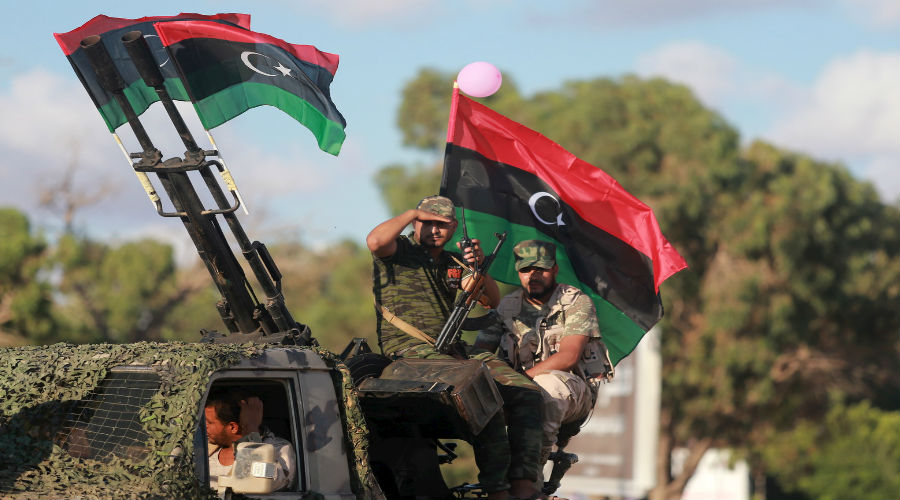ISIS attacked the headquarters of the Libyan National Oil Corporation on 10 September 2018, causing considerable material and human losses. The attack is the latest in a series of attacks by ISIS against Libyan oil and petroleum installations over the past years, taking advantage of the unstable political and security conditions in the country. Such repeated assaults may hamper the efforts to maintain the high levels of oil production reached in the recent period and put further economic pressures on Libya.
Sustained Attack
ISIS’s attack on the headquarters of the Libyan National Oil Corporation (NOC) in Tripoli left two staff members dead and 10 others injured, as the attackers employed the tactic of direct confrontation with weapons along with the explosive belts. This is not the first time that oil facilities across Libya come under attacks by ISIS. Earlier in February, ISIS carried out an assault on Al-Dhahara field, run by al-Waha oil company, killing several members of the Libyan National Army.
Over the past three years, ISIS has stepped up its attacks on Libyan oil fields and ports in the oil crescent region, benefiting from its re-positioning in Sirte, before moving, after its defeat, to various areas in the south of the country, which are not directly under the control of any of the military factions in the east and west of the country.
Among the high-profile attacks during the past years, ISIS attacked al-Mabruk and al-Bahi fields connected to the port of Sidra in 2015, along with al-Ghani oil field in the south. ISIS ramped up its attacks on oil fields in 2016 following its control of al-Mabruk and al-Ghani fields after the killing of eight field guards before the national army was able to regain control of them. Other fields, such as al-Sarir, al-Bayda and al-Samah, have also been repeatedly attacked by ISIS.
Numerous Indications
The latest incident has three important indications: the first is that ISIS still have a strong presence in the Libyan security scene, posing a significant threat, amid the constant instability and continued rift between the east and the west of the country. What reinforces its position is the presence of cells hidden across villages and towns, as well as its attempts to re-position itself in militarily unexposed desert areas in the south.
Having been driven out from Sirte, ISIS has managed to re-position itself in the south of the city and some of the border desert areas in southern Libya. That move has enabled it to forge alliances with regional armed organizations, in a way that, according to many estimates, provided it with a source to recruit new members.
This was evident in the statements made by the spokesman of the National Army Ahmed al-Mesmari, who said on March 3, 2018, that the organization staged a comeback in some desert areas in southern Libya and south of Sirte, noting that it received special support in fuel, weapons and food in those areas.
The second sign manifests itself in the inability of any party in the west and east of the country to protect the vital targets in the country, including oil installations, given that the various warring factions have almost close military capabilities, which allowed ISIS to strike the depth of Tripoli, in conjunction with the intensified armed confrontations between the military factions in Tripoli over the past weeks, as each faction is attacking vital targets in the capital.
Thirdly, ISIS is close to securing another source of funding, if it can control the oilfields, especially in the areas of the south. However, this is unlikely to happen soon, having been able - after leaving Sirte- to secure other sources of financing, such as cross-border smuggling, selling oil derivatives, and drug trafficking, a major turning point in ISIS’s influence in Libya that threaten to boost its terrorist operations.
Possible Fallout
Currently, ISIS may not have the ability to control key oilfields, as it did in Syria and Iraq over the past years, when it staged lightning attacks to sabotage oil fields and pipelines at first and then control them. This is mainly due to the focus of international efforts on curbing ISIS influence and its activities across the Middle East, which is evident in the air strikes by the US Africa Command (AFRICOM) against ISIS leaders in Libya, like the precision airstrike on June 6, 2018, which eliminated key al-Qaeda leaders in Bani Walid, northwest of the country.
Certainly, the above-mentioned developments put additional pressures on the Libyan oil sector, which is plagued by a prolonged and persistent struggle between the two governments, in the east and west of the country. In practice, the repeated attacks by ISIS on the positions of the National Army and oil crescent will disrupt production, from time to time.
Meanwhile, the National Army forces will be forced in the coming period to concentrate their efforts on striking ISIS’s strongholds in the south, which may lure the Eastern Libyan forces to conduct new strikes on oil fields in the oil crescent with the aim of controlling them, a possibility that many analysts warn of, hence the oil installations will come under sustained attacks.
In conclusion, it can be argued that this conflict, in which new actors, like ISIS, are involved, will aggravate the economic woes facing Libya and will have direct repercussions on its political stability and security.


